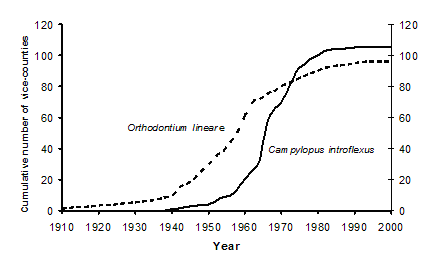Case StudiesCampylopus introflexus and Orthodontium lineareThe mosses Campylopus introflexus and Orthodontium lineare have been introduced to the northern hemisphere from the southern hemisphere. The first European records of both species were from Britain, the Orthodontium in 1910 and the Campylopus in 1941. While Orthodontium lineare was found in the United Kingdom about 30 years before Campylopus introflexus, the latter seems to be the better coloniser. The accompanying graph gives an idea of the rates of spread of the two species through the British vice-counties. For the purposes of biological mapping Britain is divided into 112 vice-counties. These are based on the traditional British counties, but with a number of those subdivided into smaller, more uniform areas. The vice-counties were introduced in the 1850s and those definitions are still used for the purpose of biological surveys, despite the changes since then in government administrative regions. The stability in the boundaries of the vice-counties allows accurate comparison of historical and modern data. The horizontal axis in the graph shows the years, from 1910 to 2000 and the vertical axis the cumulative number of vice-counties for which each of the two moss species have been found. Despite the Orthodontium's three decade head start, by about 1972 Campylopus had caught up, having achieved in about 30 years what had taken Orthodontium about 60 years.
When looking at a graph such as the one given here one question that needs asking is: Does the graph reflect the real rate of spread or does it simply indicate greater numbers of people looking for the two species in the later years? Once British bryologists became aware of the two introduced species it is reasonable to expect that they would have kept a look out for it during field excursions. As more people searched for the species in more places the chances of finding them in more vice-counties would have increased. The graph might simply show the results of intentional searching in later years as opposed to accidental discoveries in earlier years. The graph is taken from the source given in the reference at the end of this page. The authors of that paper gave some thought to that question and presented evidence that supported the view that the graph gives a good indication of the real rate of spread. They also noted that not all vice-counties have been equally well investigated, especially in the earlier years so, though a good indication, the graph is not necessarily a perfect record of the species' spread. Ireland was much less investigated in the early years and is excluded from the analysis. Another question that arises is: Why are the Campylopus and Orthodontium rates of spread so different? Campylopus introflexus reproduces readily from deciduous leaves and this helps the moss establish a large colony fairly quickly once it has reached a given area. A good-sized colony is of course a source of even more propagules – deciduous leaves for increase in local colony size and spores for colonization of more distant areas. Orthodontium lineare produces copious spores but no readily shed vegetative propagules. The SEXUAL VS. VEGETATIVE page discusses the roles of the two types of reproduction. The two-prong strategy is likely to be one factor that gives Campylopus introflexus an edge over Orthodontium lineare. Another significant factor is that Campylopus introflexus can colonize a greater variety of habitats than Orthodontium lineare. Orthodontium lineare is predominantly a colonizer of rotting wood, though it may be found on rocks or soil, but in woodlands or forests. Campylopus introflexus grows on soil or rocks in a variety of habitats, from forests to "waste" areas, such as roadside verges. Orthodontium lineare was first found on the European mainland in 1939, outside Berlin, and the first mainland European record of Campylopus introflexus was from Brittany in 1954. By the year 2000 Orthodontium lineare had been found in many parts of north-western Europe as had Campylopus introflexus, but the latter had also spread to southern France, the north-western Iberian Peninsula, Italy, further into Scandinavia, Lithuania – and had even reached Iceland. Outside Europe Campylopus introflexus has been found in western North America from California to British Columbia.
|
![An Australian Government Initiative [logo]](/images/austgovt_brown_90px.gif)


